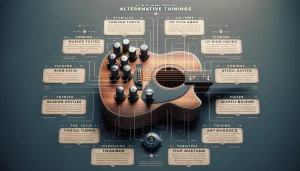Tips for Building a Strong Foundation in Fingerpicking
Start With the Right Hand Position
Imagine your hand as a delicate machine, each finger a cog in perfect harmony. To set up that ideal movement, keep your fingers relaxed yet engaged—like they’re poised to pluck ripe fruit without bruising it. Your thumb should hover gracefully over the bass strings (E, A, and D), while your index, middle, and ring fingers find their home on G, B, and high E.
Don’t claw at the strings; instead, aim for a smooth, rolling motion. It’s not about brute force—it’s finesse. If your wrist feels tight or tense, reset your position. Comfort is key!
Build a Daily Practice You’ll Actually Stick To
Let’s make practice feel less like a chore and more like a ritual. Start small and stay consistent. Here’s a simple way to structure practice:
- Play a steady alternating bass pattern with your thumb—try switching between the low E and A strings.
- Add melody notes with your other fingers, one at a time. Focus on clarity, not speed.
- Use a metronome to build rhythm—slow and steady beats a rushed mess every time.
Remember, even guitar gods like Segovia started with shaky hands!
Common Mistakes and How to Avoid Them

Slipping into Bad Habits Without Noticing
Fingerpicking is like walking a balance beam—small habits can throw you off track. One common blunder? Over-reliance on your thumb. Many beginners treat the thumb like the group leader, relegating their other fingers to mere backup singers. Trust me, your index and middle fingers are more than ready for a starring role! Try assigning your thumb to bass notes and letting the melody shine through your other fingers.
Another silent saboteur: poor hand positioning. If your wrist is too tense or your hand hovers awkwardly above the strings, you’re inviting discomfort to set up camp. Instead, keep your hand relaxed and float naturally over the strings. Picture holding an invisible ball; that’s the curve you want.
- Skipping slow practice: Speeding up too soon can lead to sloppy movement. Always start slow—it’s not boring, it’s building precision.
- Avoiding patterns: Sticking to just one picking pattern makes your playing predictable. Experiment with different rhythms to keep things fresh and exciting.
The Overlooked Danger of Ignoring Dynamics
Here’s the deal: fingerpicking isn’t just about hitting the right notes—it’s about how you hit them. Playing everything at the same volume is like painting with only one color. Sure, it works, but where’s the drama, the emotion, the surprise? Practice adding dynamics by plucking some notes softer or harder. Imagine whispering secrets and suddenly shouting enthusiasm—your audience will hang on every note!
Exercises to Enhance Finger Dexterity and Coordination

Fine-Tune Your Fingers with Focused Exercises
If you’ve ever felt like your fingers have minds of their own when fingerpicking, don’t worry—you’re not alone. Achieving the graceful coordination of a skilled guitarist takes practice. The good news? With the right exercises, your hands can feel more like a finely-tuned orchestra rather than a chaotic jam session.
Start simple: Spider Walks. Place your fingers on the strings as though they’re little creatures inching along. Move one finger at a time up and down the strings. This quirky exercise improves independent movement—essential for precision and grace.
For rhythm control, try alternating thumb movements. Pluck the bass notes (E, A, or D strings) with your thumb while simultaneously playing a melody on the high strings with your other fingers. It’s like patting your head and rubbing your stomach—not easy at first, but it works wonders for coordination.
The Power of Speed Drills
Speed isn’t everything, but controlled speed is. Turn to roll patterns:
- Pluck strings in a steady pattern (e.g., thumb-index-middle-ring).
- Gradually increase tempo without sacrificing accuracy.
- Focus on even volume for every note—it’s all about balance!
These drills will train your muscle memory, giving you the confidence to tackle complex pieces with agility and finesse.
Incorporating Dynamics and Rhythm in Fingerpicking

Bring Your Fingerpicking to Life
Fingerpicking isn’t just about hitting the right strings; it’s about crafting a story with your music. Imagine painting a canvas—without dynamics, it’s all one shade. Who wants that? To captivate listeners, you’ve got to add light and shadow, softness and intensity.
Start by experimenting with volume. Try playing the bass notes a little softer while letting your melody lines sing louder. This subtle shift instantly adds layers. For example, think of the difference between a lullaby gently rocking someone to sleep versus the fiery opening of a flamenco piece. It’s the same technique, but *oh*, how different they feel!
Locking In with Rhythm and Feel
Rhythm is the heartbeat of fingerpicking, and let me tell you—it’s impossible to fake a steady groove! Start small: sync your thumb with a metronome until it feels like it’s part of your hand. Then, spice it up:
- Add pauses mid-pattern for dramatic effect.
- Syncopate one string while keeping others steady.
- Tap on the guitar body for percussive flair.
These tiny tweaks pack serious emotional punch. Soon, you won’t just play songs—you’ll breathe life into them.
Advanced Fingerpicking Techniques to Elevate Your Playing

Unleash Your Inner Virtuoso with Creative Picking Patterns
Ready to take your fingerpicking to the next dimension? It’s time to move beyond the basics and explore advanced techniques that bring personality and flair into every note. Think of your guitar strings as a blank canvas—your fingers are the paintbrushes that create texture and emotion. One way to deepen your artistry is by experimenting with intricate picking patterns.
For example, try employing the **Travis Picking Twist**, where you alternate bass notes while weaving in off-beat melody lines. It adds a bouncy, toe-tapping energy to your playing. Or, dive into melodic arpeggios with the **Harp Effect**—let your fingers sweep across the strings like they’re gliding through water, creating lush, cascading sounds.
- Percussive Slaps: Add rhythm by slapping your thumb against the strings for a drum-like effect.
- Pinch Harmonics: Use your fingertips to produce high-pitched squeals, adding color to solos.
Each technique isn’t just about learning the motions; it’s about mastering the *feel*. When executed well, these methods make your playing less predictable and far more captivating. Your guitar will thank you!
Master the Thumb-Index Dance
Here’s a secret: advanced fingerpicking lives and dies by the connection between your thumb and index finger. These two digits need to tango like performers who’ve been practicing for years. A common technique to try is **”cross-string picking”**, where your thumb takes care of the bassline while your index finger jumps across multiple middle strings. It’s tricky at first, but once it clicks, it’s an incredible way to give depth to your playing.
Picture this: your thumb becomes the heartbeat, steady and grounding, while your other fingers add the embellishments—a symphony in miniature. Incorporating syncopated rhythms or introducing “ghost notes” (quietly played notes that add texture) can completely transform how your audience hears your music.






